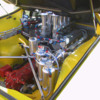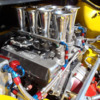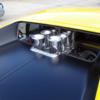PanteraDoug, that was not directed at you. I can tell you have the love/hate haha.
You can not get immunized against Webers. Once you are infected, it is for life. It is the individuals issue at how to keep it under control? It gets ugly at times. 
I don't think that BossW hates them, he is just trying to warn you that there is no coming back...from the "Dark Side"? It modifies your brain.
I don't think that BossW hates them, he is just trying to warn you that there is no coming back...from the "Dark Side"? It modifies your brain.
Great to see these in your car!
How does the decklid fit? Any thoughts of swapping the intake stacks for air cleaners yet?
I have been warned from many people to stay away from Webers. The biggest complaint seems to be from people who drive to different elevations all the time. It must be something with the individual carb nature that causes more noticable differences when going from one elevation to another. I discussed this with Jim Inglese, and he thinks they can be jetted to envelope some elevation change.
Honestly, those who have Webers tuned to near perfection love them.
How does the decklid fit? Any thoughts of swapping the intake stacks for air cleaners yet?
I have been warned from many people to stay away from Webers. The biggest complaint seems to be from people who drive to different elevations all the time. It must be something with the individual carb nature that causes more noticable differences when going from one elevation to another. I discussed this with Jim Inglese, and he thinks they can be jetted to envelope some elevation change.
Honestly, those who have Webers tuned to near perfection love them.
The clearance is just fine. I have no thoughts on going to air filters for now. The car doesn't get too many miles so I'm not too worried. Looking at it now, the valve covers look horrible, so I picked up a new set of ford racing.
Don't listen to the Weber haters, if it's something you like, go for it. It does take a lot of time to source out all the parts, that's the only think I will say. Oh yeah, they are a lot more expensive then your standard 4bbl haha.
Don't listen to the Weber haters, if it's something you like, go for it. It does take a lot of time to source out all the parts, that's the only think I will say. Oh yeah, they are a lot more expensive then your standard 4bbl haha.
Very well done!
quote:Originally posted by Edge:
The system does include coolant temp & RPM.
When we made the new exhaust system we fitted a socket for the O2 sensor.
This was plugged in during the dyno runs to get the correct fuel/air ratio, but the Motec does not use it.
The MAP feeds off of a vacuum port on each throttle body.
I’m pretty sure it’s for atmospheric pressure correction.
The Motec has provision for more sensors & given more time in the future it will be expanded upon to refine the tune.
Inlet air temp sensor is possible, could be fitted above the velocity stacks, or in the side of one.
I also have a cam angle sensor which plugs in where the Distributor was, not set up yet.
There is a spring loaded connection between each throttle body that has a screw adjustment for synchronizing.
I’m not right up on the tuning of this system & I need to learn a lot more.
It’s been a steep learning curve.
I have simply done all of the mechanical side & the manufacture of components etc.
I have a friend who does the electrical & another who has tuned on the Dyno.
So I rely heavily on them for tuning input.
Kelly, your comments here are most helpful, the more information the better.
I like the Kinsler throttle wheel that would give a nice progressive feel.
I did consider a vacuum pump but was trying to get it right using manifold vacuum & reduce the number of electrical accessories.
I may need to chase down an OEM type vacuum pump from a modern car.
We are machining up new rims right now, (17x9.5” front & 19x13” rear).
I have some 8 piston Brembos to put on the front; they tuck nicely in the 17” rims with big Wilwood rotors, so I will need good vacuum supply.
Regards,
Tony.
Pantera Chris,
You’re referring to this setup.
I did end up getting the injection running really well, simply by re-adjusting the air bleed screws.
It’s as reliable as a modern injected car without all the headaches of having to constantly tune a carburetor or set distributor timing.
Set & forget.
Throttle response is snappy & the intakes howl at high revs.
And it has that Webber look.
I call them “My music makers”.
Now the car is off the road again receiving new body panels.
Regards,
Tony.
You’re referring to this setup.
I did end up getting the injection running really well, simply by re-adjusting the air bleed screws.
It’s as reliable as a modern injected car without all the headaches of having to constantly tune a carburetor or set distributor timing.
Set & forget.
Throttle response is snappy & the intakes howl at high revs.
And it has that Webber look.
I call them “My music makers”.
Now the car is off the road again receiving new body panels.
Regards,
Tony.
Attachments
quote:Originally posted by 72pantera:
Stillllll working on it.
Webers are a lifestyle. Get used to it.
There was no IDF manifold for the C when I did mine in 1980.
The DT was a collectors item and Hall copied it and introduced his own for the IDA's.
Furthermore, I went to the A3 Motorsport heads then and Hall introduced an IDA manifold to fit those.
I do like the idea of the carbs under the deck lid and the screen but in my case I was also being heavily influenced even subliminally by the Gp4 cars.
Having the carbs stick out is part of the satisfaction of having them. Kinda like a woman with DD's wearing a C cup push up I suppose?
Yes these things are sexual for sure.
I'd like to see details of the entire set up when you get them working, rather than hold out for them to be finished, I don't think Webers are truly ever finished?
As with the above lady, I don't know if it is courageousness or foolishness that makes you want them, the Webers and the lady, but in any case..."welcome to the Dark Side Luke".
There must be a reason why they look so good in black?
Corey...Webers are NEVER running PERFECTLY...get with the concept.
Attachments
PanteraDoug-
My post says "nearly perfect".
My post says "nearly perfect".
Black does look pretty sharp. I noticed on another pic of your's you had vacuum lines from the carbs, any reason you didn't go electronic vacuum pump? Seems a lot easier.
quote:Originally posted by 72pantera:
Black does look pretty sharp. I noticed on another pic of your's you had vacuum lines from the carbs, any reason you didn't go electronic vacuum pump? Seems a lot easier.
The vacuum manifold is there so I can monitor engine vacuum and I think that one of the issues with lack of longevity of engines running 8 stack Weber systems is because of a lack of a PCV system.
Not only is the vacuum gauge plumbed in, but PCV is too.
The power brake booster is still there because that's how all of the Panteras were built.
Personally I don't need power assist on them and don't really know why the cars were built with it. They don't need it.
I could care less about how much power assist I get on the car.
I felt the same way about the assist, whats the point really. I am going to keep it though, since it's already in place.
72Pantera have you got those IDF's on and sorted yet? If so what is your opinion on them?
One more little comment: all the books say 'run 3 psi fuel pressure in Webers'. This is erroneous; whats more important is enough fuel VOLUME for the engine's intended use. One of my more satisfying 'tunes' happened at a friend's CA dyno shop, where a real 289 Cobra with quad Webers was being set up for the Monterey Historics. Lots of popping & banging and it wouldn't rev above 5000 rpms. When the dyno operator asked me what I thought, I looked at the 'official' setup and suggested they remove and throw away the chrome 3 psi fuel pressure regulator. I said, you can always shut it down if the engine doesn't sound happy, so the owner reluctantly agreed. The little engine immediately soared to its 7000 rpm rev-limiter with no problem! The dyno instrumentation said all normal on all its readings. That li'l tip got me a well appreciated cold beer at Monterey from the owner a month later, and he finished his best ever Historic race.
Use a good quality pro fuel pressure regulator with at least 3/8" internal passages, although I've personally found no problem running full 351 C-std-pump 6 psi fuel pressures into Webers of all kinds on the street. Stock floats and needle/seats seem to be able to take the slight overpressure.
Use a good quality pro fuel pressure regulator with at least 3/8" internal passages, although I've personally found no problem running full 351 C-std-pump 6 psi fuel pressures into Webers of all kinds on the street. Stock floats and needle/seats seem to be able to take the slight overpressure.
If the original 289 comp Cobras are anything to emulate, what BossWrench says is an entirely true statement.
They ran no pressure regulators at all and full 7 psi to the carbs. I presume the Shelby GT40's did also, but can't verify that?
The only one I saw up close was 103 (one of the three original Team Shelby cars) when Bill Wonder owned the car in the '70s. It had Gurney Westlake heads and 48 IDA's on it then but that was before my Weber life began so I didn't notice details like that.
I do know that the Shelby factory comp cars all ran SAE 3/8" id fuel hose to the Webers and for that there were special SAE banjo fittings made, not the metric fittings that come with the carbs now.
Those DO HELP the fuel volume FLOW to the carbs.
The biggest issue with stock Webbers is that the inlet valve and seat, original ones, are crap.
On IDA's I have run I found it necessary to run the "glass ball" high pressure valves to keep them from peculating fuel immediately after shutting off a hot engine.
I believe the only source of them is Gene Berg, and he calls them "high pressure" needle and seat. About $100 for four as I recall, but necessary. If you are running IDA's and you are using the Original Weber supplied needle and seat, change them over now before you have a barn fire.
You haven't seen anything in your life until you see your car with fuel coming out of the carbs and running all over the hot engine. Your life will flash before your eyes and I can tell you that the adrenalin rush at that instant freakin' hurts. like you got hit with an electrical shock. A big one.
Using the high pressure valves, really opens the door to running more fuel pressure but if you run dual pumps, i.e., an electric pressurizing a mechanical pump and full 3/8 lines to the carbs you are supply the volume the carbs need to feed the engine.
You should run a pressure regulator on the street. The one to run is the Holley red and set it a 4 psi. Unless you are going to run against the big factory teams at Lemans, that is all you need.
Even tuning Webers on an engine dyno at maximum rpm is a pretty hairy situation. I don't really think that is necessary, at least to me it isn't.
It isn't a bad idea either to replace the original brass floats with nitrofil ones. The amount of pressure the brass floats can stand is questionable.
I haven't collapsed any IDA floats yet, but I have on around a dozen or so Holley carbs.
You can't collapse the nitrofil and is the only safe thing to do.
It's also unpredictable what the E10 pump gas we use in the US will do to the brass floats. The alcohol content was deemed "safe" by someone, probably a vote in Congress and it probably won by one vote, so you should know what that means...I wouldn't bet my life on it? You're a big boy. You can make your own choices.
They ran no pressure regulators at all and full 7 psi to the carbs. I presume the Shelby GT40's did also, but can't verify that?
The only one I saw up close was 103 (one of the three original Team Shelby cars) when Bill Wonder owned the car in the '70s. It had Gurney Westlake heads and 48 IDA's on it then but that was before my Weber life began so I didn't notice details like that.
I do know that the Shelby factory comp cars all ran SAE 3/8" id fuel hose to the Webers and for that there were special SAE banjo fittings made, not the metric fittings that come with the carbs now.
Those DO HELP the fuel volume FLOW to the carbs.
The biggest issue with stock Webbers is that the inlet valve and seat, original ones, are crap.
On IDA's I have run I found it necessary to run the "glass ball" high pressure valves to keep them from peculating fuel immediately after shutting off a hot engine.
I believe the only source of them is Gene Berg, and he calls them "high pressure" needle and seat. About $100 for four as I recall, but necessary. If you are running IDA's and you are using the Original Weber supplied needle and seat, change them over now before you have a barn fire.
You haven't seen anything in your life until you see your car with fuel coming out of the carbs and running all over the hot engine. Your life will flash before your eyes and I can tell you that the adrenalin rush at that instant freakin' hurts. like you got hit with an electrical shock. A big one.
Using the high pressure valves, really opens the door to running more fuel pressure but if you run dual pumps, i.e., an electric pressurizing a mechanical pump and full 3/8 lines to the carbs you are supply the volume the carbs need to feed the engine.
You should run a pressure regulator on the street. The one to run is the Holley red and set it a 4 psi. Unless you are going to run against the big factory teams at Lemans, that is all you need.
Even tuning Webers on an engine dyno at maximum rpm is a pretty hairy situation. I don't really think that is necessary, at least to me it isn't.
It isn't a bad idea either to replace the original brass floats with nitrofil ones. The amount of pressure the brass floats can stand is questionable.
I haven't collapsed any IDA floats yet, but I have on around a dozen or so Holley carbs.
You can't collapse the nitrofil and is the only safe thing to do.
It's also unpredictable what the E10 pump gas we use in the US will do to the brass floats. The alcohol content was deemed "safe" by someone, probably a vote in Congress and it probably won by one vote, so you should know what that means...I wouldn't bet my life on it? You're a big boy. You can make your own choices.
Add Reply
Sign In To Reply




